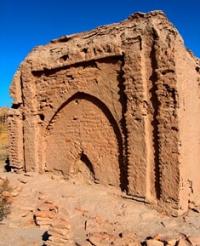You are here
Shamun nabi mausoleum.

Cultural tours in Karakalpakstan.
"From the sigh of the first on the day of its birth, the soul rushes to the day of disappearance."
Maarri al-Maarri.
Excursions to main attractions of Karakalpakstan.
The Shamun Nabi mausoleum is located on a natural hill 104.6 meters above sea level on the Mizdakhan necropolis, 132 meters south and slightly east of the Mazlumkhan Sulu mausoleum, 4.6 kilometers west and slightly south of the city of Khojeyli, 1, 1 km to the north-east of the ancient settlement Gyaur kala (Khojeli) in the Khojeli region of the Republic of Karakalpakstan.
The Shamun-nabi mausoleum, dating from the XIV - XIX centuries, is located next to the Jumart kassab hillock. It is a rectangular structure, the main facade of which is emphasized by a portal and is oriented to the east.
Inside the mausoleum there is a rectangular room elongated in plan, covered with 7 successively placed domes. Tleukhana adjoins the western side of the mausoleum. Inside the mazar there is a huge tombstone, 25.31 meters long, attributed to the “saint” Shamun nabi.
The tomb is false, there is no burial under the tombstone. Almost all the cult objects of Mizdahkan are associated with the number "seven". Seven domes are believed to have been erected in honor of the seven beauties - the daughters of Shamun Nabi.
There is a legend according to which Shamun Gaziin (Nabi) was gifted with the abilities of a healer and a palvan, and could also work miracles. He came to these places to preach religion. Here Shamun nabi also dealt with the treatment of patients, for which he did not take payment.
According to another legend, this mysterious preacher arrived on the land of Khorezm even before the messengers of the Prophet Muhammad, and urged people to believe in the One God. Shamun (Simon) performed many miracles, healed diseases, controlled the weather and the movement of heavenly bodies, could speak the language of wild animals.
In addition, he was a fearless warrior and hero who, on the basis of faith, was not afraid to challenge the local king, whom tradition calls Gyaur - the infidel. Gyaur was considered an invincible commander and an insidious politician, but out of pride he met Shamun in hand-to-hand combat, relying, however, on his own cunning.
During the duel, he threw a handful of grain under Shamuna's feet, he stumbled and fell on his knees in front of the enemy. But his faithful dog, at the call of the owner, instantly dug the underground passage, and jumping out between them, tore out the entrails from Giaur.
Shamun, however, could not bear the shame of his fall, and, as a sign of remorse, cut off his legs. According to legend, after his death, the Almighty had mercy on him, and his legs grew back so that Shamun could appear before the highest court as a cripple.
Geographic coordinates of the Shamun nabi mausoleum: N42 ° 24'05.46 "E59 ° 23'19.79"
Authority:
https://sovminrk.gov.uz/ru/pages/show/6202
Literature:
1. Grazhdankina NS "Building materials for the mausoleums of Mizdahkan". Architectural heritage of Uzbekistan, Tashkent, 1960.
2. Esbergenov H.E., Yagodin V.N. "Some results of the study of Mazara Shamun-nabi." VKK FAN UzSSR, No. 4, 1966.
3. Nekrasov A.A. "Inscriptions on the gravestones of the Mazlumkhan-Slu mausoleum in Mizdahkan." ZKV, vol. U, L. 1930.
4. Pilyavsky V.I. Urgench, "Mizdahkan". M. 1948.
5. Filimonov V.M. "Mazlum-Slu Palace, a unique monument of civil architecture." In the collection: Materials and research on the history and restoration of architectural monuments in Uzbekistan. Issue 1,
ashkent, 1967.
6. Yagodin V.N. "New data on the history of the religion of Khorezm." SE, No. 4, 1963.
7. Yagodin V.N. "To the study of the chronology and topography of the ancient Mizdahkan." In the collection “History, archeology and ethnography of Central Asia”. M. 1968.
8. Yagodin V.N., Khodzhayov T.K. "The necropolis of the ancient Mizdahkan". Tashkent, 1970.
9. Yakubovsky A.Yu. "Mizdahkan Settlement". EKV, vol. U, L. 1930.
Photos by
Alexander Petrov.







